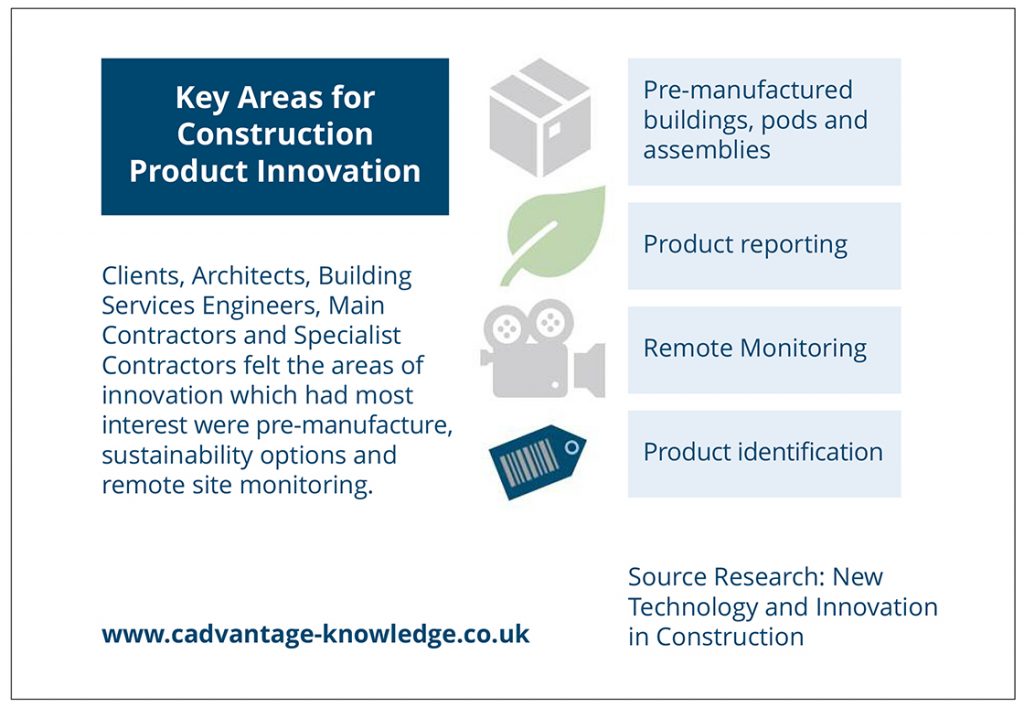Chris Ashworth, of BIM4M2 and Competitive Advantage Consultancy explores research into the future of innovation in construction product manufacturing
Traditionally, product innovation in the construction sector has been driven by changes in regulations, requiring manufacturers to add new performance characteristics to their products. Today we are at a critical point requiring significant changes in behaviour, driven by reduced skills availability, increasing costs, a greater focus on building outcomes and digital technology as an enabler.
Competitive Advantage wanted to understand how new technology and innovation is being adopted by members of the construction decision-making unit. So we conducted impartial research, seeking to provide indicators on what specifiers are looking for from manufacturers of construction products, offering up ideas on quick wins, as well as long-term innovation requirements.
How will the construction industry prioritise and adopt innovative construction methods?
Construction is now seeing innovations and initiatives to drive change in the areas of pre-manufacture, information & technology, the circular economy and new construction methods. To understand this, we talked to key decision makers; architects, engineers, main contractors, specialist contractors and housebuilders.
Competitive Advantage Consultancy’s research, New Technology and Innovation in Construction, shows that all see opportunities in these innovations, and there is some parallel thinking. While it is also clear that there is divergence in priorities as well as a reluctance to adopt new concepts in some sectors.

For construction, Industry 4.0 means using digital connectivity
Digital connectivity and cloud computing can link user, process and factory via disruptive technologies. All of this can associate with BIM and the circular economy. Industry 4.0 concepts, supported by product identification and reporting can provide designers, contractors, facilities managers and building occupants with greater information. This information will allow them to plan, build, use and maintain their buildings more effectively. This has the potential to offer cost savings during the life of the building which exceeds the original cost of building construction.
Sustainability has matured, influenced by the circular economy
The requirements of sustainability such as the inclusion of recycled materials or higher energy efficiency remain important, but we have moved on as a result of the influence of the circular economy. In the future, buildings will be designed to be easily reconfigured or even dismantled with the components reused. Construction product identifiers will be an important contributor to this, and our research showed a definite demand for products to carry identification.
Offsite construction methods are set to grow
Offsite manufacture, including volumetric construction, pods and panelised systems could provide solutions to the challenges faced by the construction industry. Our research showed these methods were considered a very useful innovation.
Pre-manufacture has the potential to improve quality while reducing cost and shortening construction times. Hardly a new technology, it was used in the UK in the 1940s to solve the housing shortage following the Second World War, yet there does seem to be fresh momentum behind this approach. With our recent Construction Market Report – UK Offsite Manufacture research showing that 77% of respondents expect this sector to grow in the next 12 months.
Conclusion
Developing new product concepts is great, but manufacturers need to address issues that decision makers are concerned about and provide solutions they are prepared to adopt. Our research shows that some of the product features decision makers want to see, are not at the edge of technology and would be relatively simple for manufacturers to make available today, such as product identifiers and offsite manufacture. The report also provides indicators in the areas of sustainability, automatic product design and installation, remote monitoring, augmented reality, manufacturer involvement and new supplier arrangements.
Our report New Technology and Innovation in Construction should help understand these opportunities. Products identified as offering the greatest opportunity are M&E systems, glazing, insulation and boarding. Pre-manufactured buildings, pods and assemblies were also seen as important contributors to innovation.
Very soon these new trends will not be the exception and companies who have failed to use innovation could find themselves left behind. There are plenty of ghosts of industry leaders left behind by technological change: Kodak, Nokia, Compaq, Blockbuster.
Chris Ashworth
Managing Director of Competitive Advantage
Consultancy Ltd and member of the BIM4M2 steering group
Tel: 01252 378053
talk@cadvantage.co.uk













